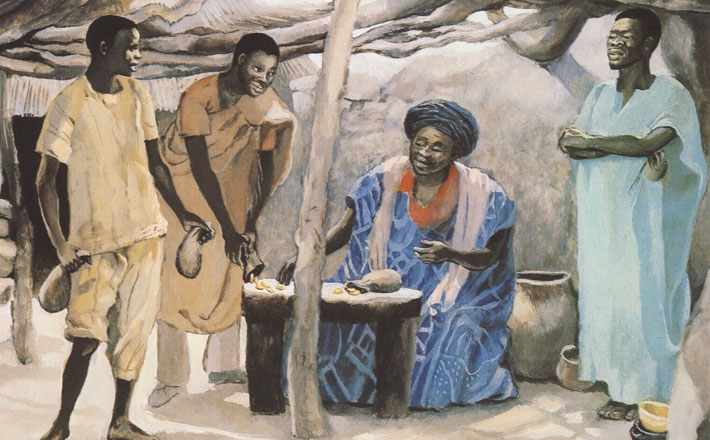Commentary on Matthew 25:14-30
There’s a lot at stake in the interpretation of this parable.
Does the parable of the talents admonish disciples that they’d better get useful or they might face judgment? Or does the parable subvert traditional images of an authoritarian and threatening Jesus? Like the parable of the virgins, the parable of the talents will raise questions among our hearers. Courageous preachers will address those questions head-on.
According to the traditional reading the parable encourages disciples to use their resources effectively for the gospel’s sake — and it warns us that we’d better get on with it. So prevalent is this interpretation that many have applied the term “talents” (Greek: talanton) to, well, talents like singing, entrepreneurship, carpentry, or public speaking. In this model a faithful response to this parable involves the creative, daring, and successful use of our talents for the kingdom’s sake. But elements of this parable will trouble some of us. What if the parable is less straightforward and its message more subversive?
The traditional interpretation stands upon a fairly reasonable assumption: the “man” we encounter in 25:14 signifies Jesus. Like the parables that surround it, the parable of the talents possesses a certain allegorical quality. Matthew 25:18 identifies the man as the “lord” (kyrios), a term that, ordinarily, simply means “master.” Matthew is particularly fond of assigning kyrios to Jesus as well as to God (in the immediate context, see 25:11).The man’s journey, then, evokes the delay of Jesus’ return, the notorious delay of the parousia.
The parable immediately before the talents, the parable of the virgins (25:1-13), deals precisely with being “ready” for Jesus’ return, a motif Matthew emphasizes (24:42; 25:13). More than other Gospels, Matthew shows interest in a final judgment, where the condemned experience “weeping and gnashing of teeth.” This parable includes that language as well (25:30). For these reasons the prevailing reading makes lots of sense: it participates in larger Matthean themes. But what if the “man” does not provide a direct stand-in for an absent but returning Jesus? What if the “man” is a scoundrel?
Commentators routinely remind us that Matthew’s parable involves talents as opposed to Luke’s pounds. We’re talking about an absurd amount of wealth in Matthew’s case. Matthew is surely capable of pressing financial imagery to its limits: we recall the merchant who sells everything he owns for a single pearl (13:45-46). But then what does he do now that he owns the pearl but has no means with which to feed himself?
Matthew does enjoy big numbers, but we might recall another dimension of Matthew’s “financial” parables: Matthew is capable of portraying scoundrels. Here we recall another parable from the cluster in Matthew 13, the parable of the treasure hidden in a field (13:44). The parable of the talents describes the man as a “rough” man (25:24). The man neither confirms nor denies this judgment, as he does in Luke (19:22), but he does acknowledge that he benefits from labor he has not performed himself (25:26).
Not long ago we treated such parables as “hyperbolic”: the stunning amounts involved simply amplified the parable’s message. More recently, especially since the financial crisis of 2008, daring preachers might reflect upon the mathematics of fabulous wealth. More than ever we are aware that a very few people routinely deal in sums that are unimaginable to most of us — and that they sometimes (often?) deal with these resources irresponsibly or even unethically. What if Matthew is showing us what can happen when a fabulously wealthy man toys around with his wealth, and with his slaves?
In significant ways Matthew’s version of the parable diverges from Luke’s (19:12-27). Among them, (1) while Matthew places this parable among others in Jesus’ final eschatological discourse in Jerusalem, Luke puts Jesus “near” Jerusalem and explains that “they” expected the kingdom of God to come immediately. Both authors link the parable to the delay of Jesus’ return. (2) Matthew assigns different amounts to each slave, each according to his ability, but Luke assigns one “pound” to each slave. In Matthew, then, the slaves differ not only in terms of their profit but in terms of their starting point, including their capacity to generate revenue.
Remarkably, both Matthew and Luke include the saying that “to all those who have, more will be given” followed by “from those who have nothing, even what they have will be taken away” (NRSV). (3) Luke’s “man” is a nobleman who rules over a country. His departure creates an attempted coup, and he rewards his faithful slaves with authority over cities. Matthew restricts the parable to money and to “being in charge of many things.” (4) Both parables include violence. In Luke the nobleman orders the slaughter of those who conspire against him, but in Matthew the violence is restricted to the slave who produces no profit. (5) Where Luke’s nobleman acknowledges that he is “hard” or difficult, Matthew eliminates that part of his confession. (6) Matthew mentions talents, far greater wealth than Luke’s pounds.
In the end we are left with a parable that for all the world seems to promote effort and risk in serving the kingdom until Jesus’ return, but a parable that worries us at many levels. The slave characterizes the Jesus figure as a “harsh” man, and he is correct. Not only does the man own slaves (though doulos does not necessarily indicate a slave), he distributes his fabulous wealth to each slave “according to his ability” (25:15), then condemns the one slave even though that slave never possessed the ability to do better.
Outdoor darkness, where people weep and gnash their teeth, awaits this man. Like the parable of the ten virgins, this parable challenges us with an apparently arbitrary, at least intimidating, standard of living and with the prospect of Jesus as a harsh judge. Is it possible that Matthew is out to subvert that model of judgment by exposing its ridiculous nature? Most of the evidence suggests otherwise, but this reader wants to know.


November 16, 2014